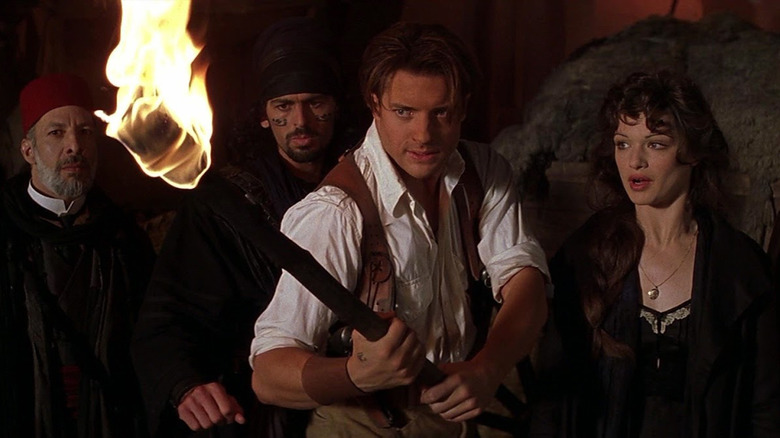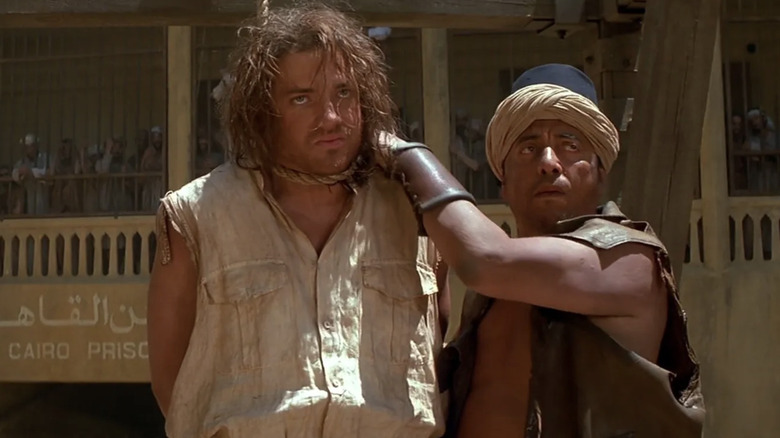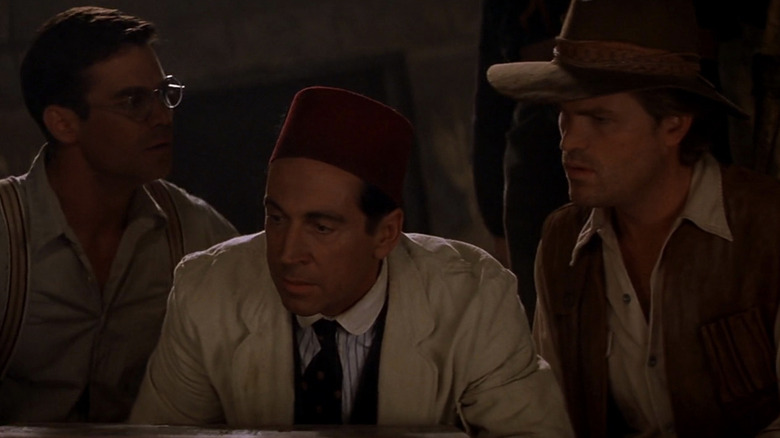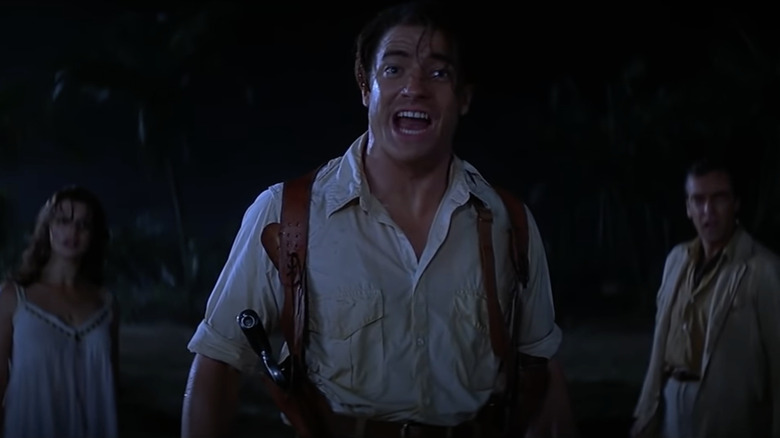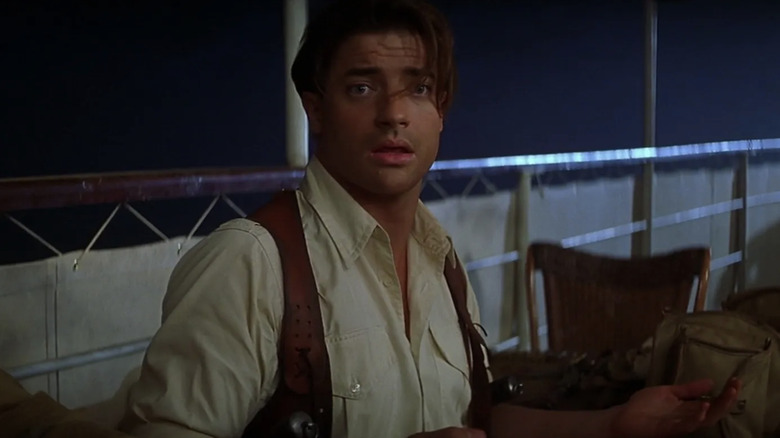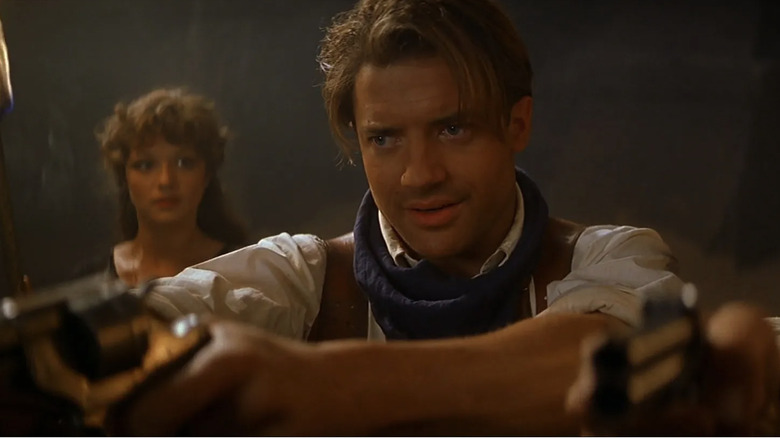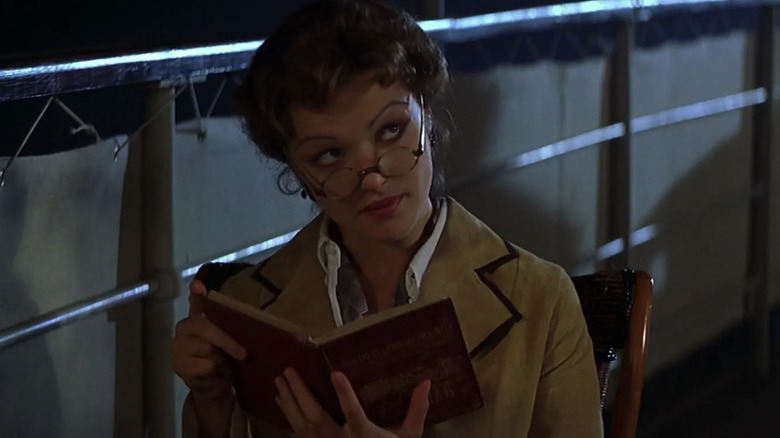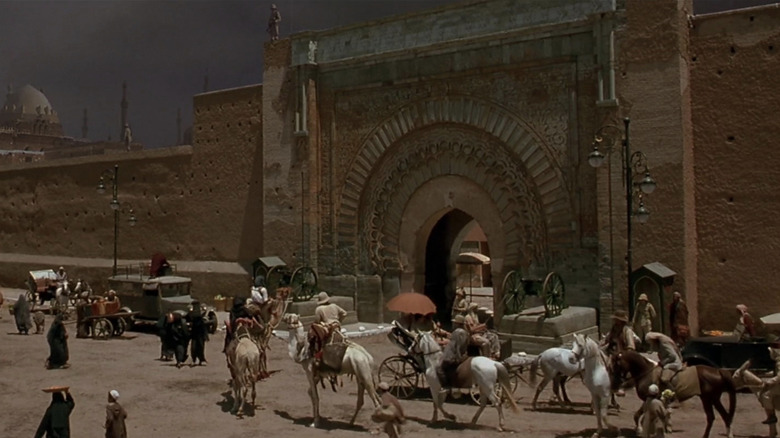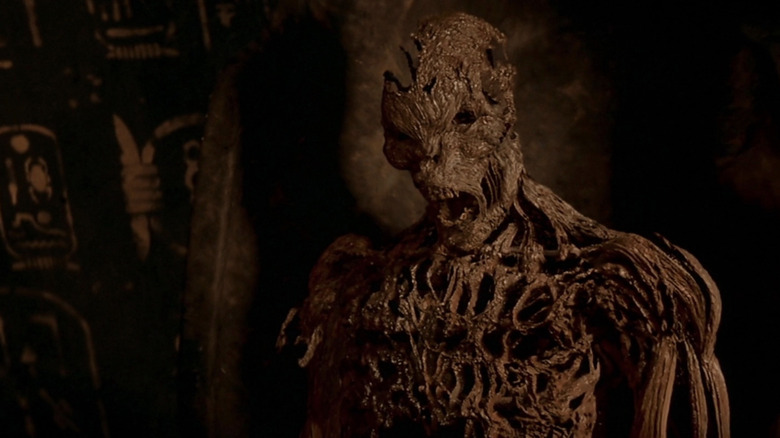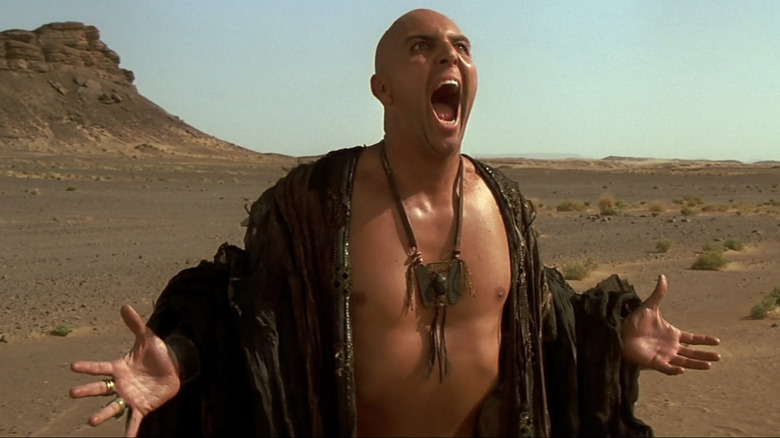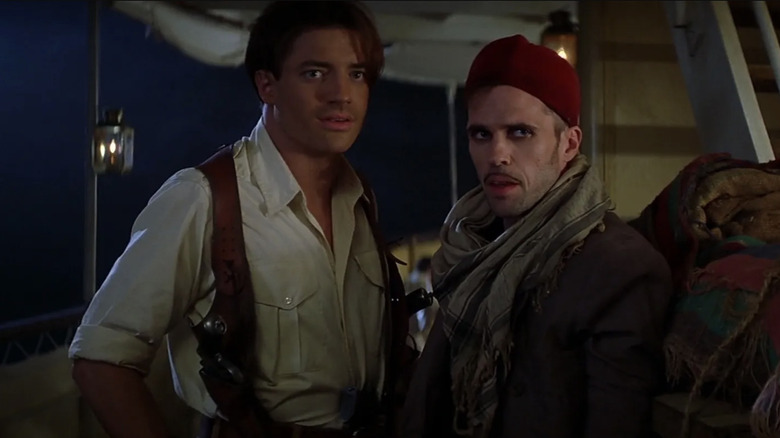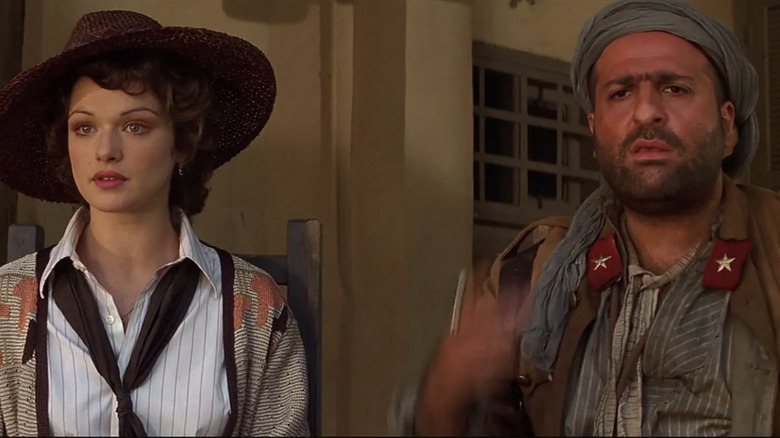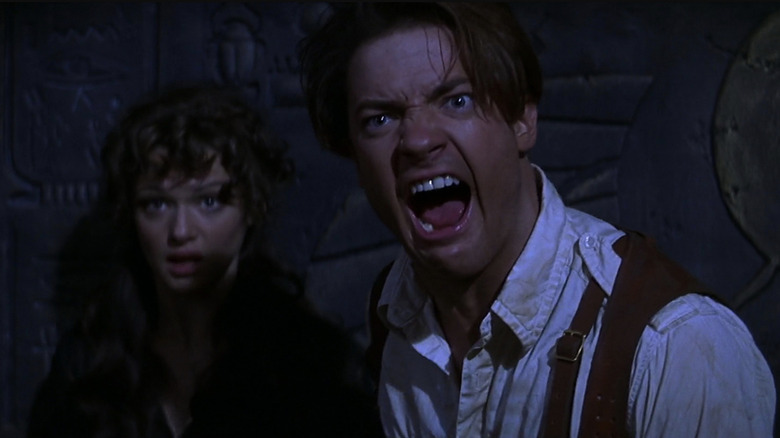Wrap Yourself In These Facts About 1999's The Mummy
No one at Universal Studios predicted that Stephen Sommers' remake of 1932's "The Mummy" would become a smashing success at the box office and an enduring action-adventure classic. Boris Karloff starred in the original film, which doesn't share much with its modern remake. For starters, no one is consumed by a giant wall of sand. Movie-goers in the late '90s were desperate for an action hero that didn't take himself too seriously and a mummy that embodied a real sense of danger. As Stephen Sommers said in an interview with Cinefantastique, "If you tossed this idea around town you'd have people saying you could easily outrun them, or why not just tear their arms off? We wanted to create something that would be frightening and dangerous."
"The Mummy" took in a whopping $150 million over a budget of $80 million, while the most stringent critics couldn't help but be charmed. According to Roger Ebert, "There is hardly a thing I can say in its favor, except that I was cheered by nearly every minute of it." The film had a winning combination of a charming, rugged action hero in Brendan Fraser, a brilliant female lead, and a host of adventurous misfits determined to ignore all warnings, open terrifying tombs, and read aloud from the book of the dead. Fresh off his success in "George of the Jungle," Fraser shared undeniable chemistry with Rachel Weisz that helped make "The Mummy" one of the most beloved films of the '90s.
Filming was a dangerous undertaking
Rick O'Connell and Evelyn Carnahan have to deal with more than a few plagues and biblical curses in "The Mummy." Oddly enough, Brendan Fraser and the rest of the cast and crew had a few plagues of their own while on set. Morocco was the chosen shooting location, but even though it was more politically stable at the time, shooting out in the desert was no easy task. Not only did daily temperatures often hit 130 degrees Fahrenheit in the morning, but Moroccan dunes were home to a whole host of dangerous creatures.
Rachel Weisz shared her memories of an actual scorpion catcher on set with The Birmingham Post: "Quite a few people were airlifted out after they'd been bitten by scorpions," said Weisz. "They used to have a scorpion wrangler who would collect them in empty Evian bottles then shake them in front of your face going 'Look what we've found." In an interview with Entertainment Weekly, Brendan Fraser talked about a particularly memorable encounter with a poisonous snake: "They sent a memo out describing a type of snake. I think it had yellow dots on it. They said, 'If you see this kind of snake, do not go near it. Because if it bites you, at best, they'll amputate your limb ... Anyway, there I was, pissing down a rock, and I look down and there's the yellow-dot snake. I was like, 'F—!' I just ran for it." Sounds delightful.
An Egyptologist was there to help with the dialogue
"The Mummy" might have been an action-adventure blockbuster with undead villains, but that doesn't mean it wasn't concerned with historical accuracy. To bring as much realism as possible to the film (when not attempting to animate corpses), Stephen Sommers called in the help of noted Egyptologist Doctor Stuart Smith from UCLA. Arnold Vosloo, who starred as Imhotep, worked with Doctor Smith to get the dialogue and the lines perfect, primarily as no one had heard ancient Egyptian spoken in over two thousand years. According to an interview with Sommers in Cinefantastique, "Doctor Smith really had to coach us." Vosloo was happy to go the extra mile to portray his vengeful mummy as authentically as possible, speaking with Doctor Smith over the phone and phonetically learning lines until 3:00 a.m.
Even the crew was committed to creating as many authentic props and sets as possible. Production designer Allan Cameron even made long trips to the British Museum to find his inspiration. "I...spent hours in their library, researching Egyptology," Cameron said. "I found this amazing volume that Napoleon had commissioned when he invaded Egypt. He had his artists, etchers, and archeologists catalog all the artifacts and tombs they found in ancient Egypt. It became our art department bible."
The movie was filmed in unexpected locations
Even though "The Mummy" is set in Egypt, filming for the movie took place in London and Morocco. While California and Arizona were both considered possible locations, it was ultimately decided that Morocco would suit their needs better. The Sahara desert, near the city of Erfoud, became the background for the desert scenes, while the city of Marrakesh would serve as the location for Cairo.
Marrakesh was seen as an excellent dupe for 1920s Cairo as it had preserved more of its traditional architecture, making it easier on the set crews. However, a few things still needed to be added and removed from the area to ensure that the city streets looked older. The film crew took down telephone poles and electrical cables to make the location appear more like 1920's Egypt. The town hall became the Cairo Museum of Antiquities, which Evelyn promptly destroys. Marrakesh wasn't the only clever city dupe, since those famous river scenes in "The Mummy" were filmed on the Thames, not the Nile. Next time we watch "The Mummy," that little fact should hopefully add more enjoyment to the scene where Rick shouts, "Hey Beni, looks to me like you're on the wrong side of the river!"
The Mummy took years to develop
While it seems impossible now to imagine "The Mummy" as anything other than a comedy-horror "hokum" flick, that's not how the film was initially planned. "The Mummy" went through over nine years of development, multiple scripts, and several different directors before being turned over to the hands of Stephen Sommers. Filmmakers like Joe Dante ("Innerspace"), George Romero ("Night of the Living Dead"), Clive Barker ("Hellraiser"), and Alan Ormsby ("Shock Waves") would all do screen treatments for a possible mummy movie with Universal Studios.
These earlier scripts were generally more of a straight horror movie, though one did have a version with the mummy being transported to Beverly Hills and wreaking havoc at a local lab. There was even a discussion about having "The Mummy" be more like "The Terminator." There's also a Hollywood rumor that Tom Cruise, Ben Affleck, and other popular male leads at the time were originally offered the part of Rick O'Connell. However, despite the popularity of said rumors, we couldn't confirm that they were correct. Sommers has stated in several interviews, Entertainment Weekly being one, that "My editor and producing partner, Bob Ducsay, as soon as he read the script, he said, 'This is Brendan Fraser.'" Obviously, Fraser was the correct choice, whatever the other options.
It was an intensely physical role for Brendan Fraser
Brendan Fraser isn't a small guy. According to Stephen Sommers in Cinefantastique, one of the reasons Fraser was chosen for the iconic Rick O'Connell role was, "At six-four and close to 200 pounds, solid rock, Brendan was a big strong guy who could throw a punch and shoot a gun, but he could also make you laugh, and laugh at himself. He has that kind of charm."
Fraser embraced the physical role and even did many of his stunts, including the scene where Rick almost dies in prison. Fraser was only needed for part of the stunt when the cameraman needed close-up shots of Rick, but in a recent interview with Entertainment Weekly, Fraser recounts blacking out during that scene. "So, the stuntman took up the tension on the rope, and I went up on the balls of my feet, then I guess he took the tension up again ... I remember seeing the camera start to pan around, and then it was ... like the Death Star powering down. I regained consciousness and one of the EMTs was saying my name." While Sommers disputes this version of events, saying that Fraser "is totally to blame" (the two remain good friends), the fact remains that filming was intense. Beyond the hangman's scene, the physical cost of "The Mummy" (and subsequent sequels) was high. Brendan Fraser needed multiple surgeries — including back surgery — after filming the trilogy due to injuries and physical strain.
Rachel Weisz did her own stunts
Rachel Weisz might have only played a librarian in "The Mummy," but she still had a lot of stunts to perform for the action film, including camel riding (which she hated). There's one stunt that stands out in the actress's mind, which she talked about with The Birmingham Post: "I didn't do that many but there was one bad one where I had to turn round to shoot a rider on a horse. He was on a pulley that yanked him off and he broke both his arms. They still used the shot though."
Prior to her role as Evelyn Carnahan in "The Mummy," Weisz was still relatively unknown. She'd starred in a few independent films and TV movies ("My Summer with Des"), and was the female lead in the Keanu Reeves dud "Chain Reaction." She hadn't made a splash with American audiences yet, but all that changed once she starred in "The Mummy." In an interview with The Mirror, Weisz confessed she'd not thought about doing a big-budget movie before. However, she says, "I read it and I thought, 'This is a funny character. She's a librarian in an action movie.'" Oddly enough, after the popularity of "The Mummy," Playboy invited Rache Weisz to model for the magazine, recreating her librarian character from the film. She declined.
The desert production was massive
Like any big-budget action movie, "The Mummy" was a huge undertaking made all the more difficult by the decision to shoot abroad. However, production designer Allan Cameron was up to the task, flying to Morocco and heading out to the dunes of Erfoud where he discovered a dormant volcano. As Stephen Sommers told Film Scouts, "A city hidden in the crater of an extinct volcano made perfect sense. Out in the middle of the desert, you would never see it. You would never think of entering the crater unless you knew what was inside that volcano."
This volcano would become an essential set for the film. Over the course of 16 weeks, a crew built the city of Hamunaptra out in the desert (interior scenes were filmed in London), complete with the ability for those sets to collapse during the final action scenes. As if building the sets wasn't enough, housing, feeding, and keeping a cast and crew of over 800 people (including 200 Tuareg horse riders) safe and healthy in the middle of the desert is no easy feat. That goes doubly for a small city that doesn't usually have 800 visitors at a time. According to co-producer Patricia Carr, accommodation was at a premium: "It was not easy finding enough hotel rooms in a small desert town which only caters to tourists who stay for one night or two at the most." Talk about a logistical nightmare.
The mummy is based on a real person
As much as "The Mummy" is clearly a work of fiction, Imhotep was not a creation of Stephen Sommers or the other two writers who worked on the film, Lloyd Fonvielle and Kevin Jarre. In the 1932 version of "The Mummy," Boris Karloff is also Imhotep and similarly searches for a modern-day reincarnation of his lost love, Ankh-esen-amun. It appears that the original film's writers John L. Balderston, Nina Wilcox Putnam, and Richard Schayer relied on ancient Egyptian mythology and folklore in their work.
Imhotep was a real person, a high priest, architect, and healer who lived sometime during the reign of the pharaoh Djoser (2667-2648 BC). From what we know, Imhotep designed the Step Pyramid of Djoser, which is located in Saqqarah. He was also a well-known physician who was deified after his death, becoming a god of medicine. Even though Imhotep never had an affair with the pharaoh's mistress, the fact that he was eventually revered as a god makes him a great candidate for a legendary curse and mystical powers over the sand. The city of the dead Hamanaptra, however, is purely fictional.
Arnold Vosloo had a lot of influence on his character
Before being cast as a murderous mummy, Arnold Vosloo was a South African actor who came to the notice of Ridley Scott for "1492: Conquest of Paradise," then later became the title character in two direct-to-video "Darkman" films. A classically trained actor and horror fan, Vosloo instantly won the role upon auditioning. According to Stephen Sommers, "Arnold Vosloo walked in. It was funny. At first, there was something kind of intimidating about him. I can't explain it. He's Shakesperean; he's serious; he's very commanding. Within 30 seconds, I knew he was going to be the guy, and I never do that."
However, Vosloo had some ideas about the character. Not only did he intend to play Imhotep straight (no camp, no silly stuff), he wanted to emphasize the character's romance. In an interview with Cinefantastique, Vosloo said, "I worked so hard in making the Mummy human. I wanted to make sure it's very understandable this guy just loves this woman." It wasn't just the motivations for the title role that Vosloo wanted to examine, but also his physical appearance. In his research, Vosloo discovered that Egyptian priests were fully shaven during that era, so he pitched the idea to director Stephen Sommers who agreed to try it out and see how it looked. It looked perfect.
There was a lot more to the character of Beni
Kevin J. O'Connor played the hilariously evil Beni Gabor, the opportunistic henchman for the mummy. Stephen Sommers, who had worked with O'Connor on "Deep Rising," called to tell him about the part of Beni, believing he'd be perfect for the role. He turned out to be an ideal fit, even creating many of the physical aspects of his character. In an interview with Jim Conlan Chats, O'Connor remembered petitioning the costume department for pants that didn't fit and growing a mustache to make the character seem even more ridiculous. He also chose to wear open-toed sandals, which he regretted on the first day of filming when something moved underneath the sand beneath his feet.
O'Connor also ad-libbed one of his most famous comedic lines praising the mummy: "I loved the whole sand wall trick. It was beautiful." At the time, the actors had no idea what this "wall of sand" would look like, so O'Connor called up the producers to describe it to him. The actor intentionally added the line to reinforce the impression of a slimy employee man "kissing up to his boss." Beni became a popular character, and even though he died in the first film Stephen Sommers talked with O'Connor about the possibility of bringing Beni back for the sequels, reanimated as a "discombobulated mummy." In the end, there was so much jammed into "The Mummy Returns" that there was no room for Beni to return.
There's been some controversy over the film
"The Mummy" was a product of a major Hollywood studio in the '90s, meaning it wasn't always the most sensitive film. While the film remains a beloved favorite for many audiences, it's not without controversy over its portrayal of ancient Egyptian culture and people of color. Since the movie's release, several actors have rethought their casting. Arnold Vosloo doesn't feel he would get the part today. In an interview with Entertainment Weekly, Vosloo said, "If it were happening today, would I get the part? I mean, here I am — white, South African. They'd probably cast a real Egyptian."
Omid Djalili (Warden Gad Hassan) had thoughts about how he would play his role of Warden from the beginning. During casting, he talked with Stephen Sommers about playing his role as lighthearted even though the script didn't call for it, in an attempt to ensure the part wasn't offensive: "I have an Iranian background, so I was very aware that, if I ever did film roles, I had to represent Middle Eastern culture. This was at a time when there were very few Middle Eastern roles at all that weren't terrorists. Steve said, 'We're looking for kind of Rifki from Midnight Express,' and that was a Turkish warden who was really evil. I said, 'Look, why don't we play him differently because, with all due respect to you, what you've written is not even one-dimensional. I can possibly get this to a two-dimensional stereotype.'"
Some of the actors had unique insurance policies
Most of the exterior scenes in "The Mummy" were filmed in Morocco, particularly in the deserts surrounding Erfoud. During the '90s, there had been a resurgence of political violence in Egypt, making it a dangerous location for film shooting. While Morocco was stable at the time, there were still some, shall we say, unique concerns over the safety of the main actors.
During filming, producer James (Jim) Jacks actually took out kidnapping insurance policies (yep, that's right, kidnapping) for each of the film's big stars. According to Brendan Fraser, the policies for the actors were worth $1 million, a decent amount of money, though Fraser had a few concerns over the figure, saying, "We were like, "So, basically, you put a bounty on our head?" He's like, "That's one way of looking at it." A fair concern. However, not all the stars had the same insurance. Kevin J. O'Connor, who played Beni, discovered that his insurance policy was only for $50,000. He wasn't too bothered about it, though, joking to Jacks that "Eh, $50,000. That should do it."
